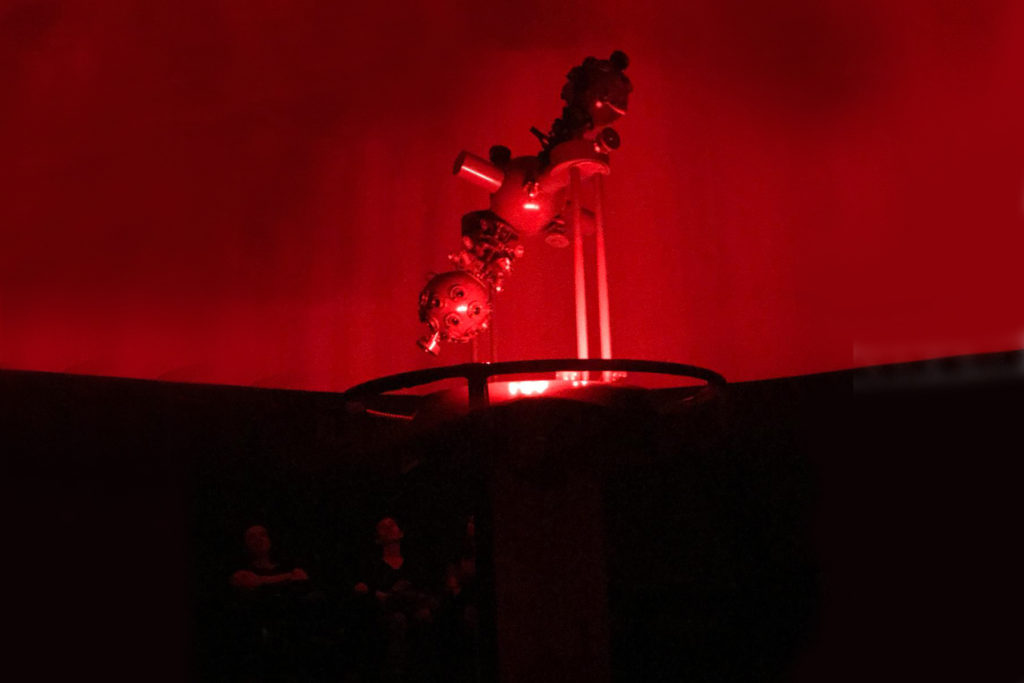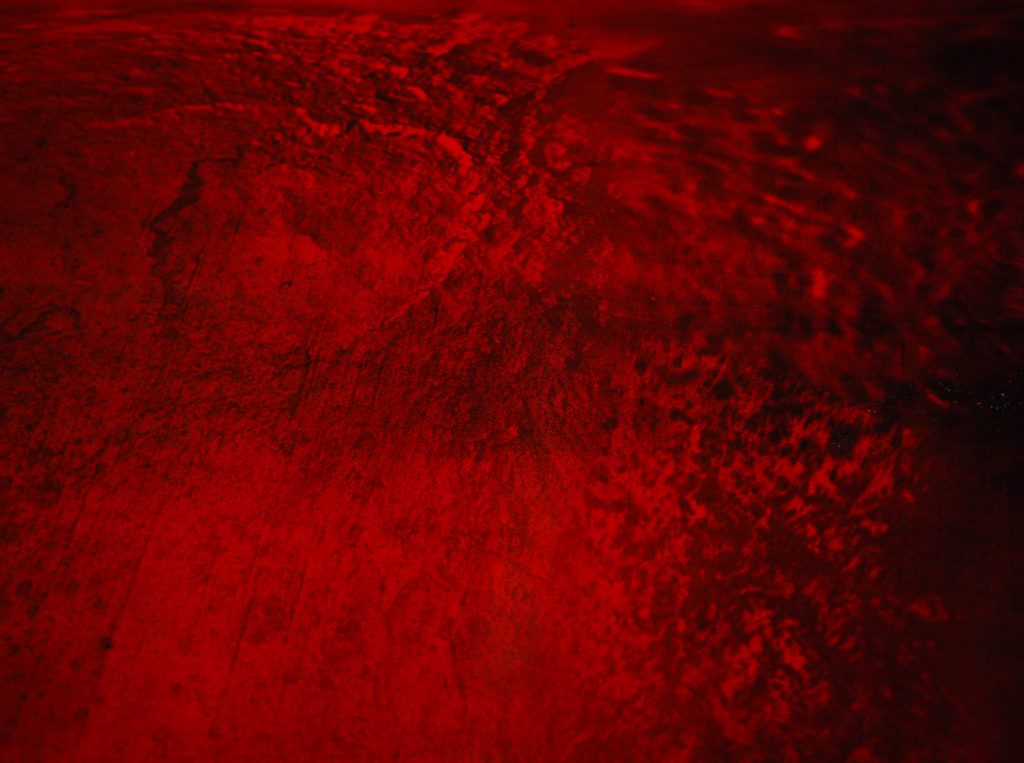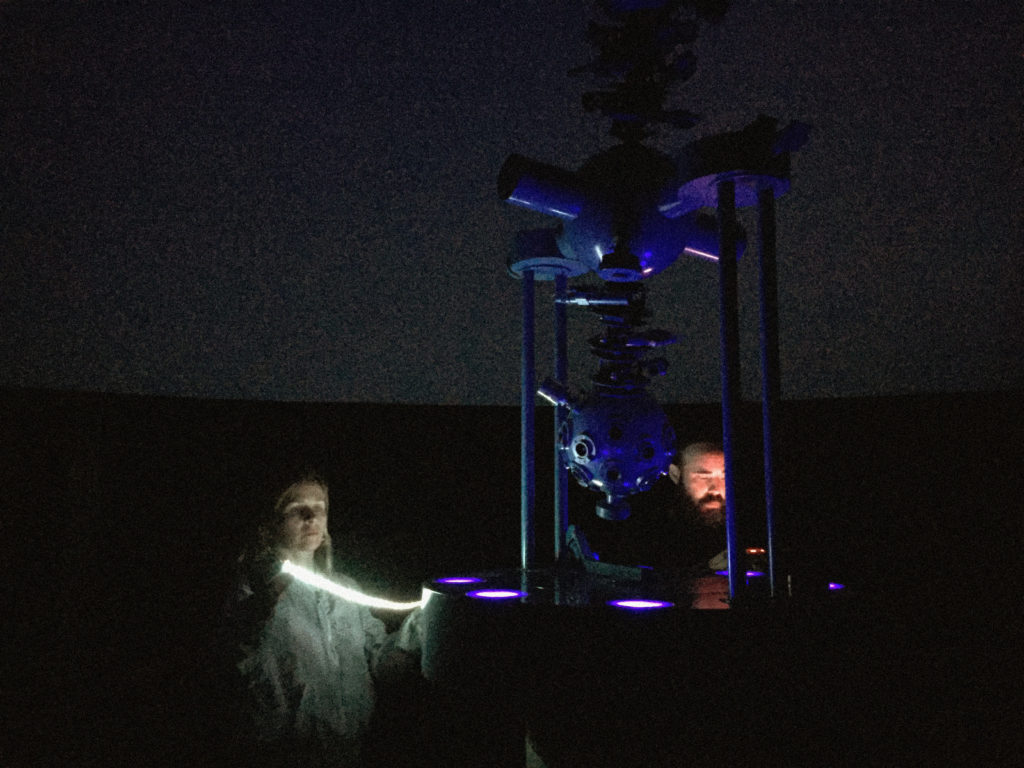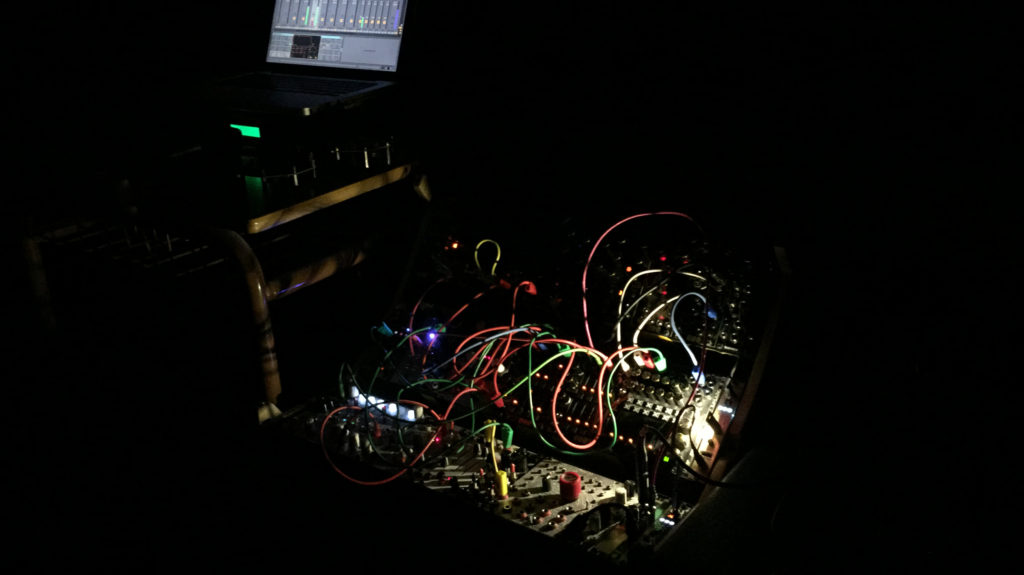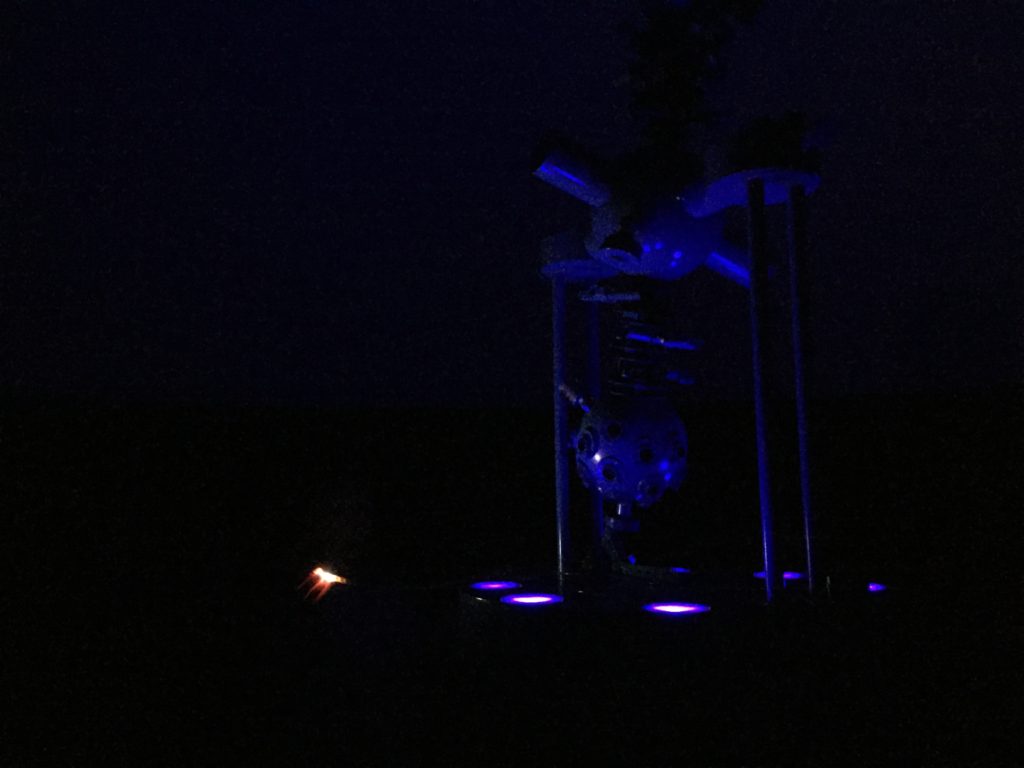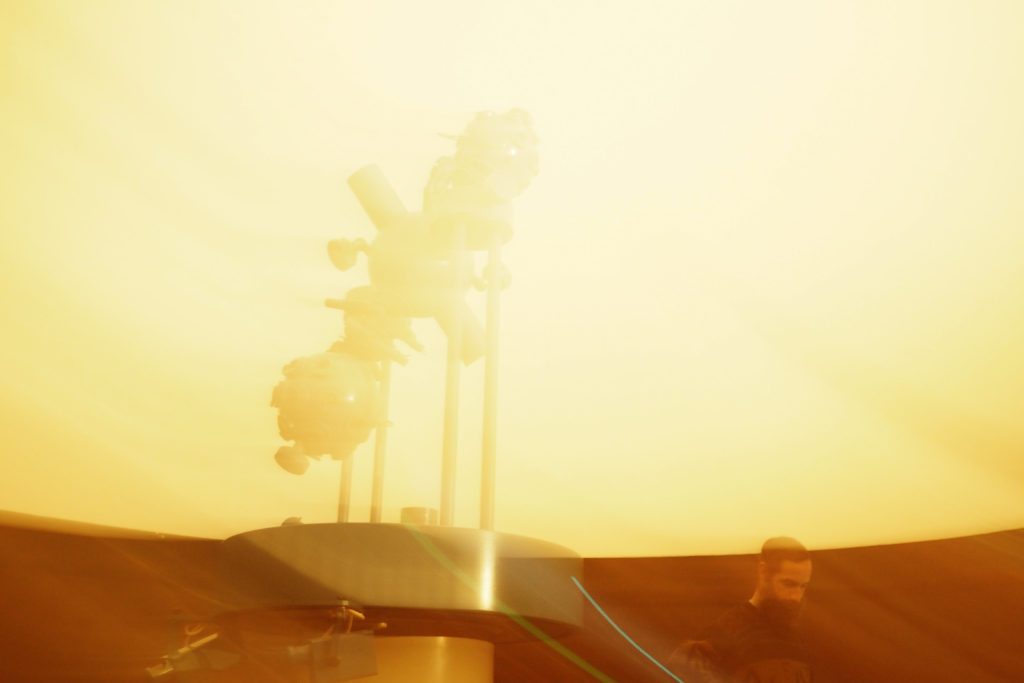zkp-2
Variations for Electromechanical Planetarium
Galactic Cannibalism
Santander Planetarium 2018
A project by
alfonso borragán, Blanca Pujals,
Víctor Mazón Gardoqui, Simon Williams y Alvaro Sau.
Duration: 35min.
Interpreted by:
Zeiss ZKP-2: Electromechanical planetary projector
E.V.A: Astro.nautica
U.K.A: Computational processor
Metal dome: Electromagnetic receiver
Pole: Electromagnetic and tectonic sensor.
emLASER: Data transmitter in light
Carbon Atmospheres: Latent images
Data landscapes: Single-channel video
Variations for Electromechanical Planetarium is an audiovisual, spatial and sensorial composition for the last electromechanical planetariums that remain in the world. ZKP-2 Galactic Cannibalism is the first adaptation, made specifically for the Santander Planetarium.
The project links the technology used in the planetarium for the representation of the celestial sphere with the contemporary technologies developed for the exploration of the cosmos and large, remote, unknown areas through radio frequencies, microwaves and other segments of the electromagnetic spectrum.
Information beyond the range of human perception.
Framework
A Planetarium is a space for knowledge production in which architecture and technology come together to reproduce the cosmos. This space represents humankind’s relationship with cosmological exploration and the simulation of the celestial sphere. A space for observation and research, a technology capable of containing the cosmos.
The first investigations in 1919 to create a machine capable of generating an artificial cosmos were developed by Walther Baursfeld at the Carl Zeiss factory in Jena. In this same factory, in 1977, the electro-mechanical projector Zeiss Skymaster ZKP-2 of the Santander Planetarium was built.
Planetary machines were the first technologies for the simulation of the celestial sphere. They only reproduce what the naked human eye can perceive of it, like humanised machinic ocular spheres, rotating from Earth. That cosmological vision placed humans at the centre of its representation.
Composition
The composition reverberates within the plaster and steel dome of the Planetarium, reaching frequencies beyond the range of human hearing and sight, interpreted by the ZKP-2 planetary machine, E.V.A. and the translation to sound of Santander’s electromagnetic spectrum. The electrically powered mechanical machine and E.V.A, interrelated and interdependent, interpret the composition in synch with the U.K.A. computer located at the entrance to the dome. The processor, through its custom-built sensors and antennas, translates and transmits in real time part of the electromagnetic spectrum, inaudible to our senses, in the form of light and sound inside the dome, generating an immersive composition. U.K.A. receives electromagnetic waves that propagate through our ionosphere, coming from space, natural radio, microwaves, electrical storms, plate tectonics or signals generated by humans in the range of telecommunications, such as GPS, GSM, WIFI and Bluetooth signals.
The sound received in the Planetarium is the superposition of the transmission and reception of different signals. On the one hand, the electromagnetic waves that collide with the metal dome of the Planetarium. On the other hand, the reception of electromagnetic frequencies from the microwave background, radio emissions or tectonic movements, picked up in the space of the gallery by means of the pole: a mast that houses a series of systems made up of antennas and sensors that react to different wave lengths and is sensitive to them. These frequencies are transferred in the form of voltage to U.K.A., contaminated and distorted by the environmental space that they travel through from the exhibition space to the Planetarium, transformed by the characteristics of the environment producing an ephemeral radio-electric fossil. The U.K.A. computer and the pole are the same connected entity that keeps on murmuring although we are no longer there to listen to it.
Situated on the apex of the planetarium’s dome is the emLASER, sending the composition—encoded in the laser beam—to the stratosphere.
Functioning as a single organism, U.K.A. and the pole exchange signals constantly, incorporating in their communications the electromagnetic landscape distorted by the electromagnetic pollution generated by telecommunications, translating the spectrum that is invisible or inaudible to humans. In the gallery space, the frequencies received by the pole are visualised by means of an electronic device which utilises a custom-designed algorithm.
The composition that takes place in the space of the Planetarium is in communication with and complemented by the exhibition located in an art gallery, made up of material produced specifically for the piece.
As two places of representation in tension, the gallery houses the Carbon Atmospheres pieces and the Data Landscapes audiovisual piece. Carbon Atmospheres are latent images made with carbon powder that are transformed and destroyed by the movement in the room. These images are impossible maps of the moons of Saturn and Neptune. Their dense, gaseous and constantly changing atmospheres are impossible to fix and represent. These images dialogue with the video essay Data Landscapes, created based on a simulator of the cosmos. This simulator, used as a video game, is capable of representing what we cannot experience but can imagine. A contemporary system of what the Planetarium could have been in the past.
All this forms the unique and transitory ecosystem of relations between the planetarium and the gallery.
Process
The project was produced by means an 18-month-long period of approximation and investigation, related to the context, bringing together interdisciplinary teams that expanded and elaborated different visions during the process.
During the development of the project, we worked with a team of specialists and experts in matters related to the project, such as astrophysicists, nautical engineers, cosmologists or communications engineers with whom we collaborated on the research and construction of the contents for the work.
During the process, the project has collaborated closely with the Nautical School of the University of Cantabria, with the departments of Astrophysics, Cosmology and Structure of Matter of the Institute of Physics of Cantabria (IFCA), with the Department of Communications Engineering (DICOM, UC), based on their research in the field of radio frequencies and microwaves and their development of technologies for satellites, as well as with the Astronomical Association of Cantabria.
In addition, and in relation to the research, different members of the group visited the European Organization for Nuclear Research (CERN), the Atacama Large Millimeter/submillimeter Array (ALMA), the Kennedy Space Center Visitor Complex at Cape Canaveral (NASA), or the Scientific Research Bases in Antarctica, based on their interest in the exploration of the cosmos, research on the origin of matter, the Universe or the monitoring of our planet from space.
During this first phase of research, prior to the production of the piece, the following actions were carried out:
· Interviews with experts in navigation, astronomy, meteorology and oceanography.
· Transdisciplinary research workshops with a group of twelve artists and scientists familiar with the context.
· Recording in video and audio of the research.
During the workshop sessions developed over three months, between October and December 2017, the interdisciplinary group of artists and scientists got together to work together on ideas related to the project and addressed from their different disciplines.
The workshops were organised as a series of meetings and visits to spaces of the context that are relevant to the research. During this process, the following sites were visited for the development of the research:
Santander Planetarium, Cantabria Astronomical Association, Astronomical Observatory of Paramo de Lora, Hydraulic Institute of Cantabria, Dept. of Electronic Technology, Systems Engineering and Automation at the Nautical University (for its unmanned submarines and processing of sonar images), Department of Optical Physics and Laser Optical Physics, the Laboratory of Microwaves and Radio in Image of the Department of Communications Engineering, the Institute of Physics of Cantabria (IFCA), and a sound and synthesis studio. During these visits, interviews and work sessions were coonducted, among others, with Juanjo Revilla (lecturer of the Santander Planetarium), Andrés Ortega Piris (Nautical Guidance), Juanjo Achutegui (First Director of the Planetarium), Neila Campos (Astronomer and PhD in Applied Mathematics), Javier Ruiz (Astrophysicist), Paco Velasco (Dept. of Electronic Technology, Systems Engineering and Automation at the Nautical University), Fernando Moreno (Applied Optical Physics), and interviews with José Luis Arce (Laser Optical Physics), Tomas Fernández (Communications Engineering), José María Zamanillo (Communications Engineering), Rocío Vilar (Director of the Institute of Physics of Cantabria, IFCA, and Particle Physicist), Alicia Calderón (Particle Physicist) and Francisco Carrera (Astrophysicist), and Pablo Gallo (Experimental musician).
Credits
The following people have collaborated in the process: Juanjo Achutegui, Director of the Nautical School of the University of Cantabria until 2008. Jose Luis Arce, Optical Physicist. Electronic technology and systems engineering and automation, UC. Neila Campos, Astronomical Association of Cantabria. Francisco Carrera, Astronomy and Astrophysics, IFCA, UC. Tomás Fernandez, Telecommunications and Microwave Engineer, UC. Pablo Gallo, Experimental Musician and Sound Technician. Felix Gomez Agustí, Optics of microscopes. Jordi Llorca, Chemist specialised in meteorites. Institute of Energy Technologies, Polytechnic University of Barcelona. Fernando Moreno, Applied Physics, Optics, UC. Carlos Nieto Andreu, Hydraulic Institute of Cantabria.Andres Ortega, Sciences and Techniques of Navigation and Naval Construction, UC. Juanjo Revilla, Santander Planetarium lecturer. Javier Ruiz, Physicist and Researcher. Astronomical association of Cantabria. Roberto Sanchis, Astronomer. K2 telescope. Berkeley University (San Francisco, US) Eva Valle, Santander Planetarium Lecturer, Nautical School, UC. Francisco Velasco, Naval Engineer. Superior Technical School of Nautical, UC José Vicente Casado, Star Geologist. Investigator. (León, Spain) Rocío Vilar, Vice-director, IFCA, UC. Jose María Zamanillo, Telecommunications Engineer. DICOM, UC.
Working Group in October and November 2017: Belen Barandica, Architect, Teacher and Artist. Angela Barreda, Optical Physics, Master in Physics, Instrumentation and Environment, PhD in the Science and Technology program at UC. Alfonso Borragán, Multidisciplinary Artist, Master and Doctorate at Slade University College London and Teacher in Arts and Sciences in UCL, London. Raul Fernandez, Cosmologist and Physicist, Poet, Anthropologist, PhD in Sciences, Technologies and Computing from UC. Tamara García, Multidisciplinary Artist. Susana Gomez, Artist, Gemologist and Criminologist. Marta López Mazorra, Actress, Rhapsodist and Theatre Director, Founder and Director of the Arte en Escena de Santander company. Arturo Pardo, Telecommunications Technologies Engineer, PhD in the Department of Photonic Engineering at UC, Electromagnetism, antenna modelling and object-oriented programming. Jonathan Piedra, Particle Physicist, Researcher at the Institute of Physics of Cantabria and Professor at the Faculty of Sciences of the UC, has participated in the discovery of the Higgs boson and is currently investigating the origin of dark matter. Blanca Pujals, Architect, Audiovisual Artist, Spatial Researcher and Critical Writer. RCMI / Rob Telecommunications, Programming, Cryptography and Self-Management.

